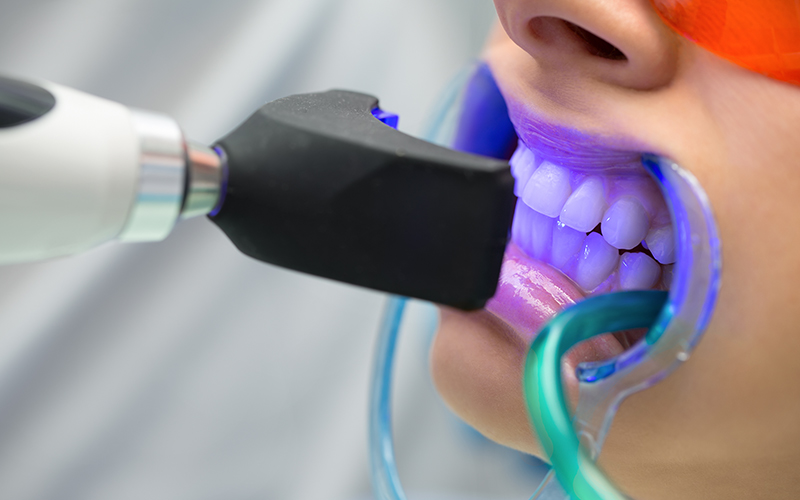Healthy and white teeth are an element of great aesthetic importance among people. Teeth whitening procedures performed to have whiter teeth are treatments frequently applied by dentists in recent years. Teeth whitening; It is the process of removing colored, organic and inorganic substances formed in the porous enamel structure on the surface of the teeth with tooth whitening gels.

Why is teeth whitening needed?
The appearance of teeth is important for people who take care of their personal care. Shape and discoloration of teeth can even cause psychological disorders. In addition to natural teeth whitening methods that can be applied at home using herbal methods, many color, shape and position disorders can be easily resolved thanks to the development of aesthetic and restorative materials in dentistry. In addition to some methods such as home teeth whitening with baking soda, the use of products such as whitening toothpastes and teeth whitening pens, there are also some medical teeth whitening treatments applied by dentists. Among these, the bleaching method of stained teeth is more economical, easier and effortless compared to other restorative methods.
Why do teeth lose their whiteness?
Structural disorders that occur during the formation of teeth in childhood, some antibiotics exposed to during infancy or while in the womb, foods and beverages consumed in daily life (coloring substances such as cigarettes, tea and coffee), and the amount of fluoride in drinking water can cause discoloration on the teeth.
This color change in teeth is divided into two:
Internal discoloration: These are stains that have penetrated into the tooth and cannot be removed by brushing. Structural disorders that occur during the formation of teeth (due to medications or excessive fluoride intake, etc.) also fall into this class. The whitening process is very successful in the majority of such cases.
External Discoloration: These are the discolorations that adhere to the tooth surface from some staining foods such as cigarettes, tea, coffee and cola. It is usually possible to get rid of these stains after cleaning the teeth.
Different colorations require different treatments. For this reason, it is best for your dentist to decide what type of treatment should be performed.
What are the teeth whitening methods?
Teeth whitening methods are divided into two different types according to the application technique:
Power Bleaching performed within an hour in the office environment; It is the fastest, most reliable and effective whitening system consisting of whitening gel and light, which can lighten teeth color by 3-4 shades in a short time.
Teeth whitening at home (Home Bleaching); It is a whitening process performed by placing gels into personalized plastic mouthpieces with a simple oral measurement. The desired whitening is achieved in approximately 5-7 days. It needs to be worn for 4-8 hours a day (may vary depending on color and gel).
Can anyone have teeth whitening?
Anyone who does not have any dental or gum disease that prevents the procedure can have teeth whitening treatment, but a dentist examination is required before whitening. Those with advanced cavities and gum disease in their mouth should have the whitening process applied after having their treatment done by their dentist. Apart from this, teeth whitening is not recommended for people who have not completed their growth and development, pregnant women and breastfeeding mothers.
Is teeth whitening safe or will it damage teeth?
Research and microscopic studies; has shown that there is no harm in using a 10 percent whitening solution. There is not a single study showing that teeth whitening causes structural changes or permanent damage. Different concentrations of medications can be used to whiten teeth, but the dentist must decide how and how much they will be used.
Do everyone’s teeth whiten at the same rate?
Teeth whitening treatment does not give the same results for everyone; How much the tooth color will be lightened depends on the structure of the tooth.
What are the side effects of teeth whitening?
All whitening gels cause more or less sensitivity in the teeth. This sensitivity to cold and hot drinks and air may cause discomfort to people. This is a normal and expected side effect of the application. If sensitivity does not subside within 24-48 hours, bleach use may need to be discontinued. In case of sensitivity, the fluoride your dentist will apply and the toothpaste or creams he will recommend will reduce this tooth sensitivity. As another option to reduce sensitivity, toothpastes containing potassium nitrate can also be used.
How long does the whitening effect last?
The result of the whitening process varies depending on the person’s tooth structure and remains constant for approximately 6 months to 2 years. Of course, this period also depends on the person himself. Substances that stain teeth should be avoided for at least two weeks during and after whitening.
If you are having problems with the color of your teeth, you can consult your dentist for teeth whitening treatment, and if your teeth are deemed suitable for whitening as a result of the examination, you can have the procedure done as soon as possible.

